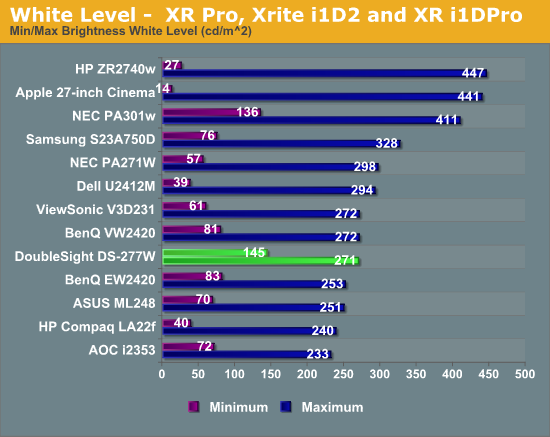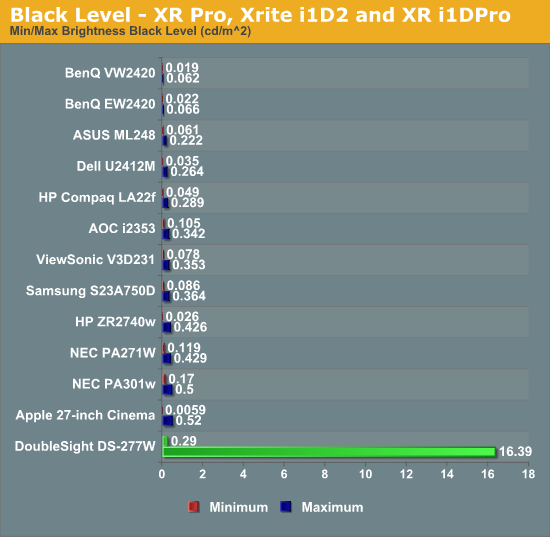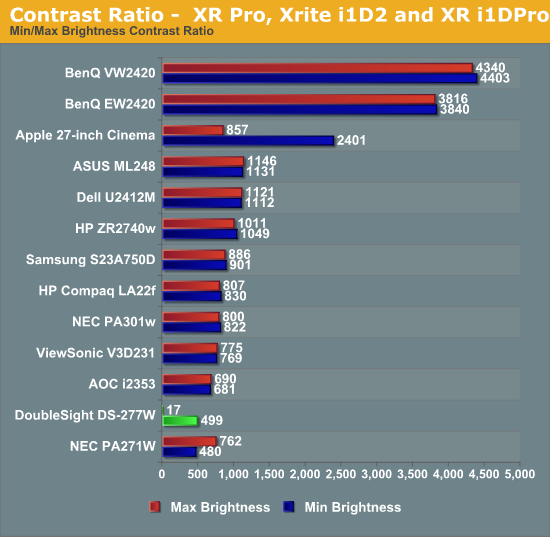DoubleSight DS-277W: Back to the Drawing Board
by Chris Heinonen on June 13, 2012 1:30 AM ESTMost of the 27” monitors that have come through have been able to get incredibly bright, as the backlighting systems need to be pretty powerful to light up a 27” panel well and keep uniformity. Here the DoubleSight comes in closer to the NEC PA271W than to the other 27” or 30” monitors we have tested and can only put out 271 nits at maximum brightness. With the brightness set to minimum we only get down to 145 nits, which is much brighter than anything else we have tested, and it means that our 100 nits dE testing required lowering the output level by adjusting the LUTs in the video card, which can cause posterization and other issues.

The black level at the minimum backlight is 0.29 nits, which is pretty reasonable. I also engaged the dynamic backlighting system and that dropped the level on a black screen down to 0.189 nits, which improves the contrast ratio quite a bit. Unfortunately, you can clearly see the dynamic backlight in use, and the screen fluctuates in brightness very clearly, which I found to be very annoying in use. The main issue is looking at the black level at maximum brightness, as it is over 16 nits! That’s over 32 times as bright as the closest display and really out of the ordinary, so what is going on?

The answer lies in how TV and Monitor controls work. On a TV, brightness controls the level of black, and contrast controls the level of white, and on a flat panel TV there is typically a backlight or cell light control to adjust the light output. On a monitor, there is no backlight or cell light control; brightness handles that. Since computer displays use the full 0-255 RGB gamut, unlike video that uses 16-235, there is no need for a black level adjustment. On the DoubleSight, the electronics are designed to work like on a TV, so instead of adjusting the light output, we are adjusting the black level. Similarly Contrast serves the purpose now of controlling white and the maximum light output. Basically, for use as a computer display, these controls are not designed correctly.
Given that black level, we would expect to see the contrast ratio at maximum light output be pretty poor, and it clocks in at 13:1. At minimum it was a respectable 499:1 and even at 200 nits I measured around 400:1, but once the brightness gets too high, your contrast ratio goes away.

Suffice it to say, the DS-277W was not a good performer on the brightness and contrast testing here. Hopefully that doesn’t carry over to every aspect of the display.










55 Comments
View All Comments
esSJae - Thursday, June 14, 2012 - link
FireWire was the only solution for external hard drives until USB 2 came out. I had FW on my Dell work laptop back in 2002.FireWire was also great because you could chain devices together.
Zoomer - Wednesday, June 13, 2012 - link
nVidia, AMD and Intel have all committed to DP. They will start the phase out of DVI, probably by going to just 1 TMDS per card. Why get something that's going to be a 2nd class interface standard really soon?Most cards, even lower end ones, have come with DP for years now.
Guspaz - Wednesday, June 13, 2012 - link
My current videocard has DP. My current monitor (a Dell U2711) has DP. My monitor came with a DP cable. As a result, I'm using DP to connect my monitor.There is, however, one major downside: if both HDMI and DP plugs are connected to an nVidia card, it boots on the HDMI port. This means that on my computer, I only see the BIOS and boot screens on my home theatre projector, not my LCD monitor... this is really dumb.
Zoomer - Saturday, June 16, 2012 - link
It's a software issue that will be fixed. Maybe ask nvidia/your card manufacturer?Dug - Wednesday, June 13, 2012 - link
Thunderbolt uses the same connection as display port (mini) so I don't see it going away.SodaAnt - Wednesday, June 13, 2012 - link
Well, I am that one person. I have a Dell Precision m4600 that I connect to my Dell u3011 with a displayport cable, no adapters involted.LordOfTheBoired - Wednesday, June 13, 2012 - link
I use DP. And I adopted it before Apple did.It's a good standard, and it deserves more support than it's getting right now.
Also, Apple's new "best interface ever" is Thunderbolt. Which... uses DP for video, and the now-standard mini-DP connector.
InsaneScientist - Wednesday, June 13, 2012 - link
Every single person I know who has a WQXGA (2560x1600) or WQHD (1560x1440) monitor (myself included) has it connected using Display Port.HDMI never seems to work despite the fact that HDMI 1.4 supposedly will, and dual-link DVI (as already mentioned) is a pain since you have to make sure that the port that you're connecting to is dual link and the cable is dual link...
An $8 Display Port cable just works... assuming that the monitor supports it.
Oh, and none of the people I know with monitors at that resolution are mac users, ironically enough.
JarredWalton - Thursday, June 14, 2012 - link
Apparently everyone with a 30" WQXGA or 27" WQHD display that you know also purchased their displays relatively recently (last couple of years). I've got a 30" display and it's using DL-DVI; same goes for most others with 30" displays that I've met (all five or so of them!) But for newer displays yes, DP is becoming far more mainstream.Voo - Saturday, June 16, 2012 - link
Actually I do use DL-DVI on my relatively new Dell U3011 - why?Because Dell included the DVI cable but no DP cable in the package and I really don't see any advantages in DP over DL-DVI.